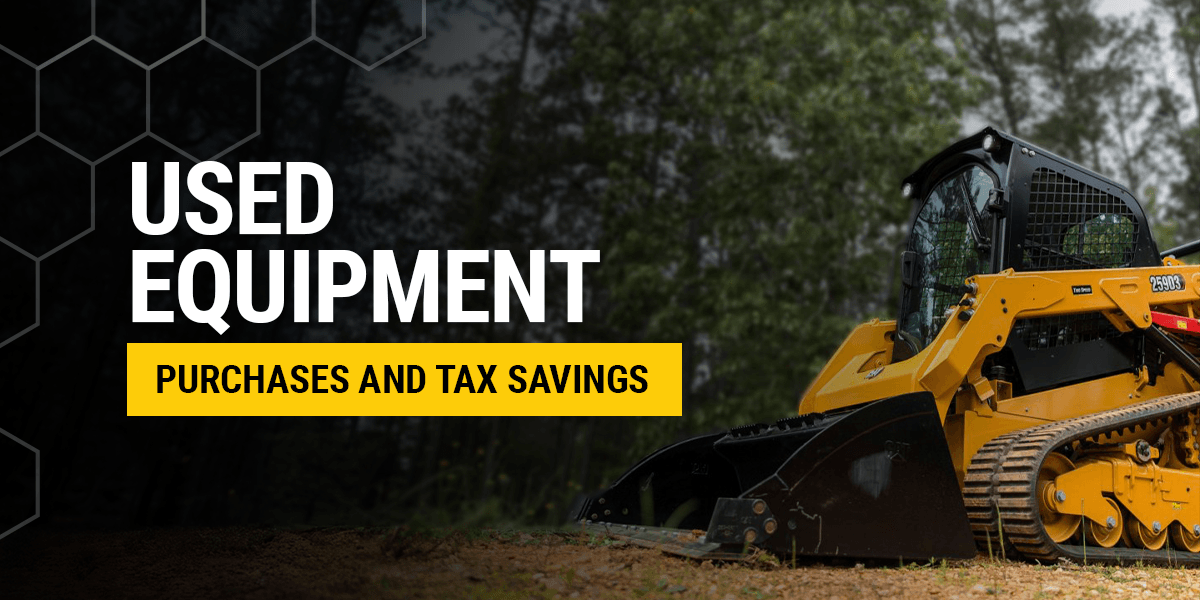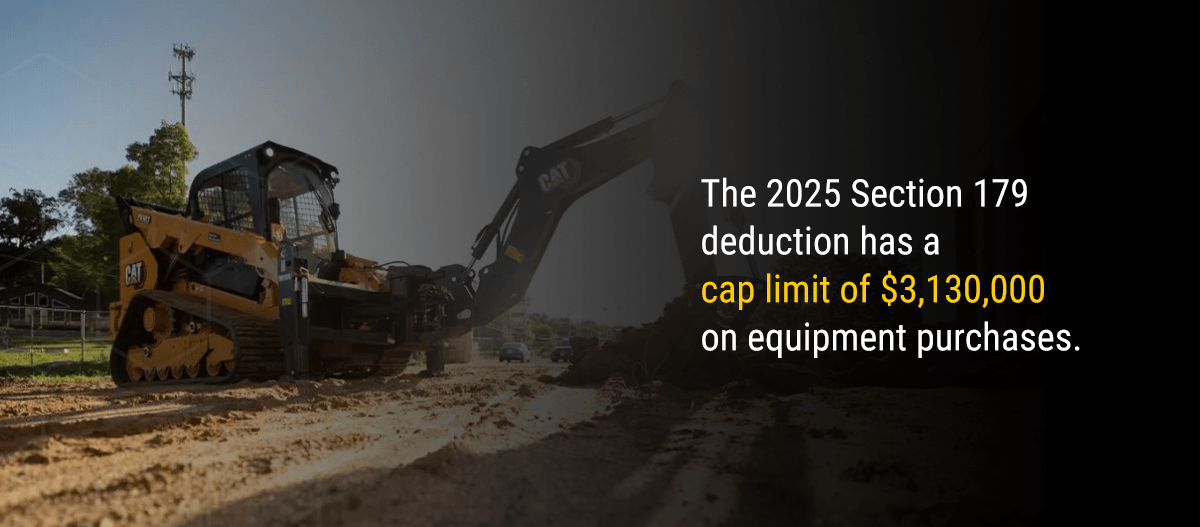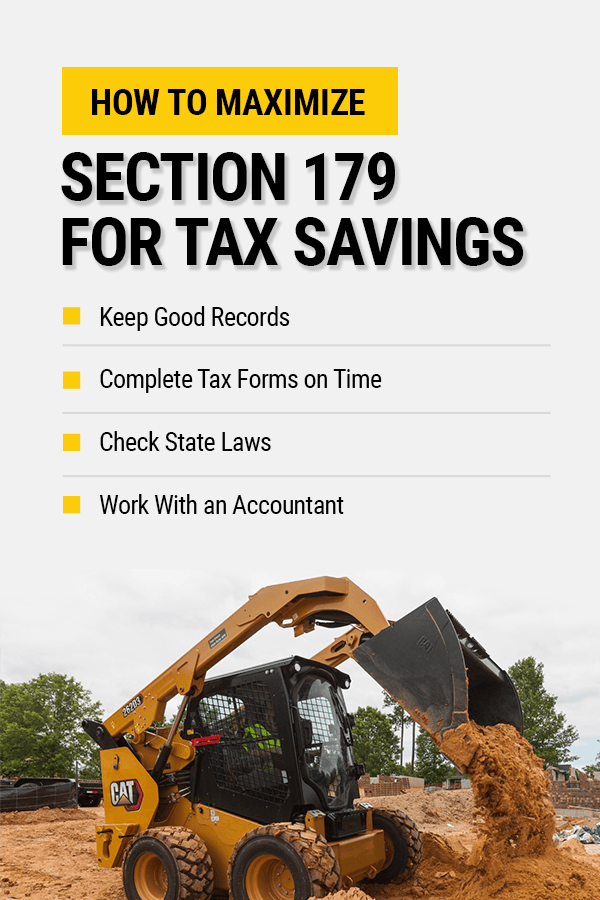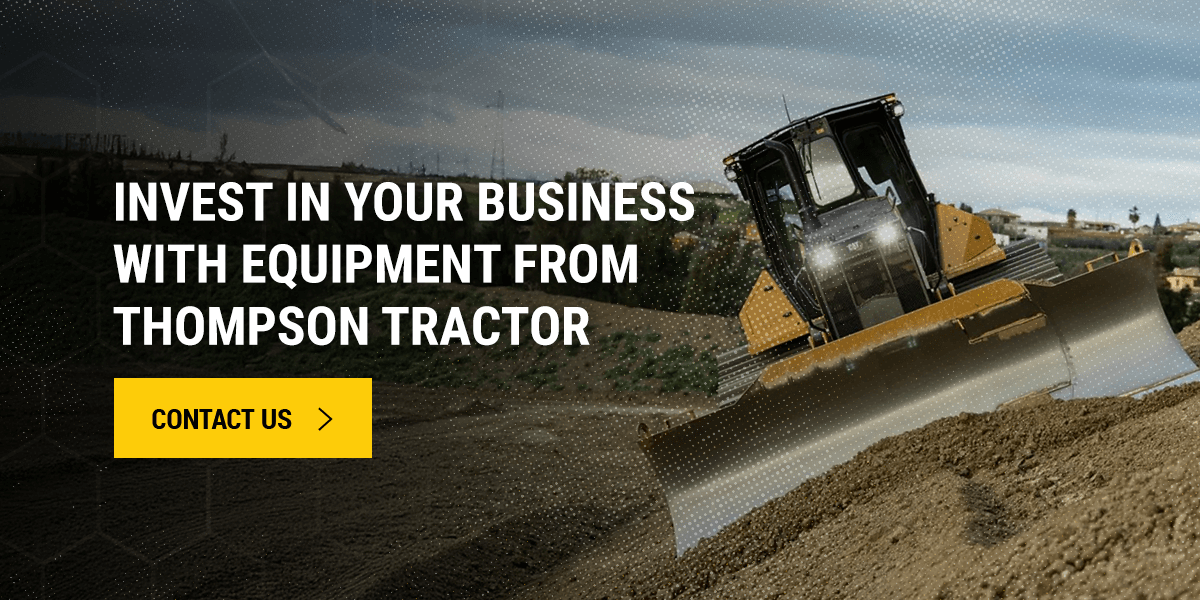If you’re a small business owner who purchased used equipment over the last year, you should consider taking the Section 179 deduction. This tax planning strategy can save a significant amount in taxes the first year you purchase and use the equipment. In this article, we’ll review the 2024 179 deduction and what it can mean for your business.
You should always talk with a qualified tax professional before making final decisions for business tax planning. However, most small business owners who make a large equipment purchase can benefit from taking the 179 deduction.
Learn more about the 179 deduction and how you can write off used machinery purchases for tax savings.
Can You Write Off Used Equipment Purchases?
Yes — according to Section 179 of the IRS tax code, small businesses can write off the full purchase price of new and used machines for the year they purchased them. This allows business owners to save a significant amount of money in taxes and reinvest that money back into their businesses instead.
By contrast, normal depreciation allows small business owners to write off a portion of an equipment purchase every year for the equipment’s expected life span. While this offers a tax break over several years, Section 179 is much more powerful because it allows small businesses to benefit from a machinery purchase immediately.
Section 179 was specifically designed to empower small business owners to invest in their businesses by making large equipment purchases. As part of a strategic tax plan, Section 179 allows you to buy equipment and reduce taxes at the same time. It’s a powerful financial tool that can help you succeed as a small business owner.
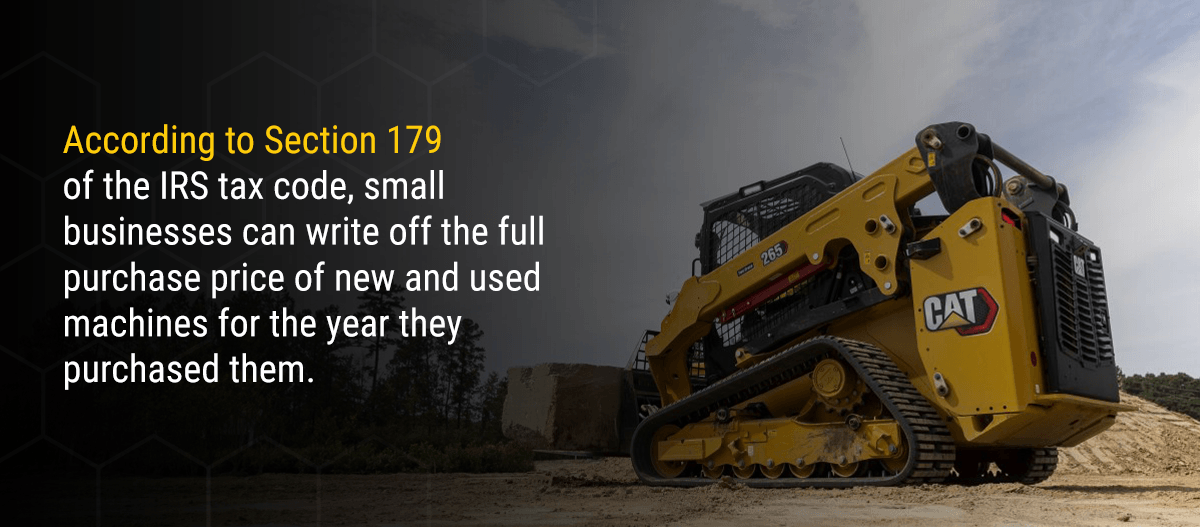
Section 179 Example
Imagine a small business owner spends $100,000 on a new piece of equipment. They have a tax bracket of 35% and take Section 179 instead of regular depreciation for their tax strategy. The Section 179 deduction allows them to write 100% of their purchase off, which in this case is $100,000.
The cash savings from Section 179 will depend on your tax bracket. If a small business owner paid $100,000 for equipment and is in a tax bracket of 24%, they would save $24,000 of the $100,000 equipment cost through reduced tax liability. Business owners in a 10% tax bracket who spent $100,000 will save $10,000 with reduced tax liability from Section 179.
What Equipment Qualifies for Section 179?
Machinery must meet several standards to qualify for a Section 179 tax deduction. If you’re unsure whether your equipment qualifies, check it against this list:
- Was the machinery used more than 50% for your business in the year you started using it?
- Is the equipment new to your business?
- Did you start using the machinery in the same year you’re filing the deduction?
- Did you purchase or finance the equipment?
If you answered yes to all the questions, your equipment most likely qualifies for Section 179. However, if you inherited the machines, were given equipment as a gift or purchased machinery from a relative, you cannot take the Section 179 deduction.
What Are the Limits for Section 179?
The maximum Section 179 deduction for 2025 is $1,250,000 — slightly higher than the limit of $1,220,000 in 2024.
You can’t receive a deduction on equipment costs that surpass this limit. However, in some cases, you can use Section 179 and then bonus depreciation to reduce taxes on equipment that exceeds this limit.
The 2025 Section 179 deduction also has a cap limit of $3,130,000 on equipment purchases. If you start using more than $3,130,000 of equipment in one year, the Section 179 deduction phases out on a dollar-for-dollar basis. This means that in general, small businesses can benefit most from the Section 179 deduction.
Can Section 179 Vary by State?
Yes, it’s important to note that Section 179 can vary by state. Although Section 179 is a federal tax law, state tax laws may have lower deduction limits for businesses. You must check your state’s rules to know how much you can deduct with Section 179.
State laws may also impact what equipment is considered eligible for Section 179. Certain types of machinery may fit the federal description but fall short of state requirements. You may also need to file additional forms when you take a Section 179 deduction, depending on state-specific regulations.
Because legal requirements can vary by state, it’s important to speak with a professional accountant before taking Section 179. They can help you understand the state and federal laws and get the best tax deduction for your location and situation.
What’s the Benefit of Depreciating Used Equipment?
In accounting, depreciation allocates the cost of an asset over its useful life. An asset’s useful life is an estimation of how long equipment or other assets will last. Depreciation empowers businesses to match an asset’s cost with its revenue over time, making accounting compliance easier and giving an accurate picture of an asset’s financial performance.
Depreciation is useful for tax planning and cash flow management because it allows you to deduct depreciation expenses from your taxable income each year. You can choose to use traditional depreciation methods for reporting new equipment purchases, or you can opt to take a Section 179 deduction instead.
Can You Depreciate Used Equipment?
Similar to the Section 179 deduction, bonus depreciation for used equipment allows businesses to deduct some of the cost of new or used property in the first year it’s purchased and used. Bonus depreciation can also help business owners with cash flow management and tax planning, allowing them to make the most of their financial resources and assets.
However, Section 179 and bonus depreciation differ in the amount they allow businesses to deduct. While Section 179 allows businesses to deduct 100% of new equipment up to the limit, bonus depreciation allows businesses to deduct a lower percentage of an item’s total cost.
Bonus depreciation was established by the Tax Cuts and Jobs Act (TCJA) in 2017. Until 2023, it allowed for a 100% property deduction. However, the rate was set to decrease over the next several years, and in 2024, the bonus depreciation percentage was 60%. You can expect bonus depreciation to decrease to 0% by 2027.
Section 179 vs. Bonus Depreciation
Some businesses may be able to use both Section 179 and bonus depreciation to get the highest tax deduction on their equipment. To use both deductions, you have to spend more than the limit for Section 179. You can apply Section 179 to your machinery costs first, then take the bonus depreciation percentage from the amount that goes over the deduction limit for Section 179.
Unlike Section 179, bonus depreciation doesn’t have a maximum deduction limit. You can use it on all new business property that has a useful life of 20 or more years. This property must be new to the business, and you must file for bonus depreciation in the same year you purchased and started using it. Examples of qualifying equipment include some business vehicles, furniture, and machinery.
Of course, you should always talk to a professional accountant before making any firm decisions with your tax planning. Your accountant will know how to best follow tax codes to reach your financial goals. For some businesses, taking regular depreciation may be a better choice than Section 179 or bonus depreciation.
FAQs for Used Equipment and Tax Savings
Still have questions about the Section 179 deduction and tax savings for used equipment? Browse these FAQs to learn more so you can make the best decision for your business.
What Vehicles Qualify for Section 179?
Many business vehicles qualify for Section 179 deductions, including some shuttle vans, cargo vans, trucks, and heavy SUVs. To qualify, the vehicle must be used for business purposes at least 50% of the time. In most cases, it must also weigh over 6,000 pounds in gross vehicle weight.
Depending on your vehicle’s specifications, it may qualify for a full or partial deduction. Like other types of equipment, vehicles can only qualify for the Section 179 deduction in the year you purchased them and they became available for use. You can learn more about which vehicles qualify by checking the Section 179 website for updated information.
Can I Take Section 179 for Leased or Financed Equipment?
Yes, you can use Section 179 to deduct the costs of leased or financed equipment for your business. How you paid for the machines doesn’t impact whether you can use Section 179. However, you can only take the Section 179 deduction for the same year you purchased and started using new equipment.
How Can I Calculate Savings From Section 179?
Section 179 has an official website with a free calculator that can help you determine your potential savings when taking Section 179. Simply navigate to the calculator page, enter the cost of your equipment, and choose your tax bracket percentage. Click “Show My Savings,” and your calculated savings will automatically appear.
How Do I Take the Section 179 Deduction?
Taking the Section 179 deduction is easy. When you file your tax return for the year, you’ll also need to complete Part 1 of IRS form 4562, available for free online. You can find the most up-to-date forms on the official Section 179 website.
If you have any questions about taking the Section 179 deduction, talk to a professional accountant. They can help you navigate the complexities of tax forms and ensure you file everything correctly.
How to Maximize Section 179 for Tax Savings
After learning about Section 179, you might wonder how you can maximize this deduction for tax savings. With careful planning, you can give your business a financial boost by deducting 100% of the cost of new equipment during the first year you purchase and use it.
The best way to maximize tax savings for your unique situation is to speak with a professional accountant. For some businesses, taking regular depreciation may be the best route financially. Other businesses may benefit from using both Section 179 and bonus depreciation. Many small businesses use Section 179 instead of bonus depreciation because it yields higher savings for them.
Here are some general tips that can help you maximize Section 179 for better cash flow management and tax savings this year:
Keep Good Records
A definite record allows your tax preparer to report the cost of machinery accurately. Ensure you record every business purchase you make and when you make it. Keep records in a safe place so they are easy to find when it’s time to report your taxes.
Complete Tax Forms on Time
If you’re working with a professional accountant, they can help you fill out and submit all required tax forms on time. If you want to take the Section 179 deduction, you’ll need to complete the additional IRS form 4562. This form is submitted along with all your other business tax forms by April 15, the deadline for most business taxes in the United States.
Check State Laws
Some states have laws that lower the Section 179 deduction for business equipment. Before you take the deduction, check your state laws to understand how they could affect your tax planning. You can still take the deduction, but the limits and percentages may differ from those listed in the federal regulations.
Work With an Accountant
To maximize your tax savings, it’s essential to work with an accountant. The U.S. tax system can be difficult to navigate on your own, and you may receive fines if your taxes are late or underpaid. When you work with a professional accountant, you can avoid additional costs and ensure your records are always in order.
Invest in Your Business With Equipment From Thompson Tractor
If you plan to take Section 179 this fiscal tax year, investing in new machinery can be the right next step for your business. Section 179 was created to make new machinery accessible for small businesses. In the same year you purchase and use qualifying equipment, you can deduct 100% of its cost and reduce your business taxes.
Thompson Tractor Company has been operating since 1957 in Alabama and northwest Florida. We’re a full-line Caterpillar dealer offering new and used machinery and parts and services for heavy equipment. We pride ourselves on delivering quality equipment that’s durable enough for your toughest projects.
We offer equipment at competitive costs and are the premier forklift dealer for Central Tennessee, Georgia, and North Alabama. Thompson Tractor has your back with quality Cat® machines you can trust. Contact us today to learn more about our equipment or browse our site to find what you need.

